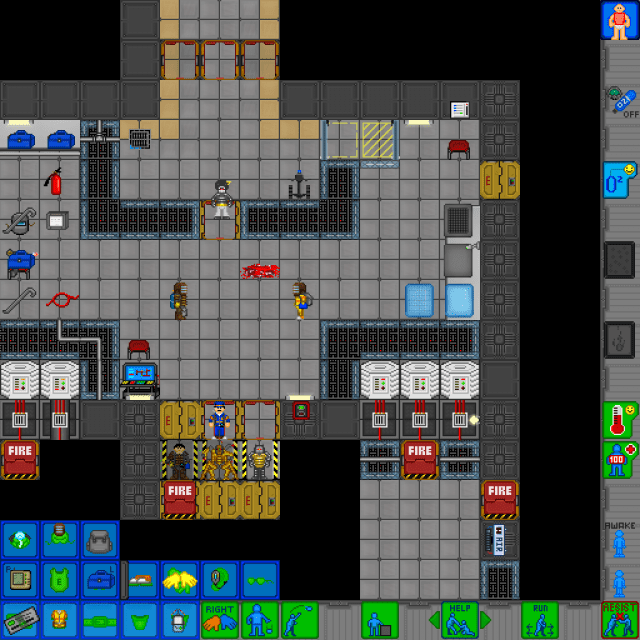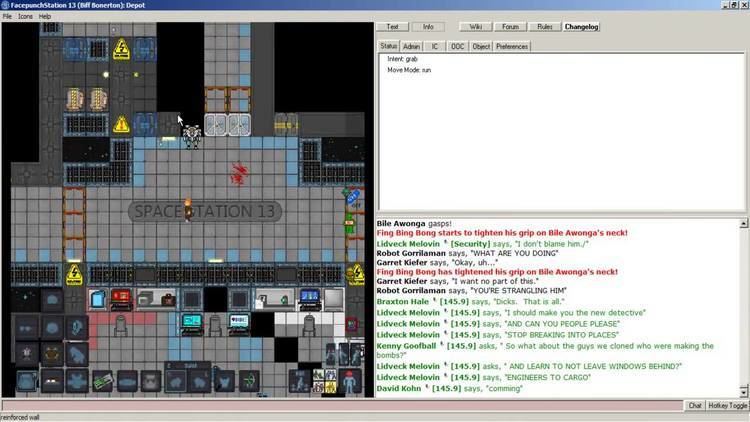Engine BYOND Developer Exadv1 | Initial release date 15 February 2003 Platforms Microsoft Windows, Linux | |
 | ||
Similar Aliens: Colonial Marines, RimWorld, Dwarf Fortress, Nox, Singularity | ||
Space station 13 review
Space Station 13 (or SS13) is a top-down role-playing multiplayer video game on the BYOND game engine, originally released in 2003. The game is tile based and is played from a 2-D angle.
Contents

Set on a futuristic space station, players choose to play from a selection of different jobs available on the crew roster; the outcome of which is determined by the interactions players have with the environment around them.

Recently the game has gained an expanding player count, sometimes reaching averages of 500 players on at any one time. Its popularity has gained it communities from websites such as 4chan, Reddit, the Facepunch Studios forums and Something Awful, as well as attention from various video game journalism websites. The game was also mentioned as an inspiration for the, now cancelled, game ION by DayZ creator Dean "Rocket" Hall.

Space station 13
Gameplay

Space Station 13 takes place on a fictional space station. At the beginning of each round, players are given time to either create a customized character using a character sheet or they may begin playing with a completely randomly generated character. Players can choose different jobs, such as janitor or engineer, which dictate their role on the space station. The game is akin to a roleplaying sandbox game, with events in each round largely being player-dictated and lacking a real objective or goal.
The player can examine and use almost any object or being on the station, and is almost always context sensitive. Different results will occur depending on many variables in any given interaction (e.g. Using a crowbar on another player would attack them but using it on a floorboard would pry it up). Additionally, the player can change their 'intent' between four different states (Help, Disarm, Grab, Harm) which will further influence actions taken. For example, using an empty hand on another player with help intent would cause you to hug them, but would cause you to punch them on Harm intent.
The game engine fully simulates power, biology, atmosphere, chemistry, and other complex object and environmental interactions beyond the vast majority of video games, which to many people, compensates for its lack of visual quality and speed.
While different servers may have their unique station constructs, generally there are eight departments aboard the station. Supply and Service are also often grouped together in the Civilian category.
Optimally everybody will spawn into the station at the beginning of each round and perform their jobs. However, randomly selected players are chosen to spawn as an 'antagonist' aboard the station. Antagonists can range from a character with secret objectives, genocidal AIs, and a wide assortment of monsters such as changelings and aliens. It can be difficult for normal crew members to identify antagonists, and even harder to determine their ulterior motives.
Due to the presence of antagonists, most rounds will end with the station left in chaos, and most others with it completely destroyed. While some servers may have an end game, often the rounds will end when an emergency shuttle is called to pick up the crew at the station.
Story
While most servers have personalized lore and backstories, generally Space Station 13 is a state of the art research station in orbit around Tau Ceti, Epsilon Eridani or an unnamed gas giant, which the megacorporation known as Nanotrasen owns. Nanotrasen's influence and power have effectively made them a government entity, but it is often left ambiguous as to whether they are good, evil or uncaring depending on the server. Due to Nanotrasen's immense stature, it is targeted by an array of third party aggressors. This includes but is not limited to; The Syndicate (a coalition of smaller companies and planetary governments), the Space Wizard Federation, Shapeshifters - Known as Changelings, Vampires, Xenomorphic aliens, Brain slugs - Known as Borers, and various other antagonists.
The station exists to research the mysterious 'plasma', (or 'phoron' on some servers), which is a newly discovered mineral that Nanotrasen has taken a keen interest in, despite having almost no knowledge of its uses or properties.
Development
Space Station 13 was kept in a closed source and originally developed as an atmospherics simulator in 2003 by Exadv1. Allegedly the source code was stolen in 2006 and leaked onto the internet, which gave rise to the current popularity of SS13.
Since then, the player count has grown and is now commonly known across many gaming discussion sites. Due to the nature of BYOND, each server has a version of the Space Station 13 code meaning that each server is an entirely unique iteration of the game with different features and content. In the past, a Mars base server has existed based on the original Space Station 13 code, with a sea lab server in development.
As of March 2017, the current five most popular code, and server, bases for SS13 are Paradise Station, Goonstation, Baystation, /tg/ station,and Colonial Marines. Each catering to a unique play style and role play standard and with many, if not most, other small servers using these servers' code. While most servers are generally English-only speaking, there are a few other servers that primarily use other languages, such as Tau Ceti Classic (Russian), Infinity (Russian) and Hispanistation (Spanish).
As the majority of the stations often have some unique code, gameplay systems (such as Chemistry) may vary greatly from server to server. Many of these servers have adopted their own wiki pages, explaining the differences.
